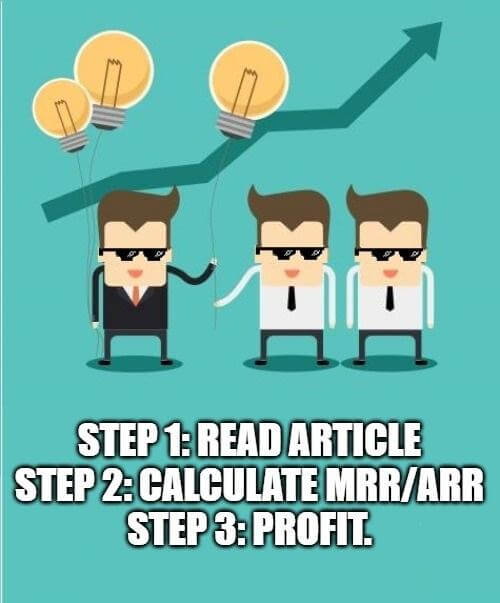Let me guess, you’re either starting a company or you’re looking to scale your SaaS for your already existing business and you’re not really sure where to start.
I feel you.
It’s a bit scary at first having to deal with finance, but don’t worry, it’s simpler than it looks.
In this quite comprehensive guide, if I do say so myself, I will gradually ease you into the information needed. i.e. how to calculate your company’s Monthly and Annual Recurring Revenue.
What is ARR?
So, let’s start with the basics. What even is ARR or Annual Recurring Revenue? Well, to put it simply (and yes, this all is very simple as you’ll see), ARR is a metric used by SaaS or subscription businesses. Your business charges its customers a recurring price at regular intervals? Well ARR is the value of the recurring revenue your business will be receiving in a year. Simple as that.
A bit about Tallyfy
Are you looking to automate tasks between co-workers or clients? You've found the right app for that! With Tallyfy - you can automate tasks and business processes - within minutes.
Let's resume the rest of this article!
What is MRR?
MRR, on the other hand, as you may have already guessed, is the monthly recurring revenue your company is receiving, a.k.a. the total value of revenue you can realistically anticipate and rely on on a monthly basis. Same as ARR, this is a metric relevant for SaaS and subscription businesses.
Why are ARR and MRR important for your business
ARR and MRR are two of the most important metrics for any startup. Go to 👉 9 Metrics to Help You Make Wise Decisions About Your Start-Up if you want to learn about the others
Both ARR and MRR are really useful for keeping track of your company’s health, growth, success and momentum – data you can rely on and then use to make accurate future decisions and action plans for your company.
ARR vs MRR – Which One Should You Use?
Let’s compare these two metrics. Generally, the key difference between them is in the particularities:
- ARR gives you a more overall/macro scale look over things vs. the more detailed/closer/micro-scale look MRR provides.
- ARR provides you with a more long-term stable estimate of your success, whereas MRR provides you with insight into your company’s gradual line of development and enables you to make more currently relevant comparisons between recurring revenue values.
- MRR is more popular and more frequently used than ARR.
- Why? Simply because ARR can only be effectively used if you have term agreements with a duration of minimum a year.
- That’s why ARR is predominantly used by B2B subscription businesses with multi-year agreements.
- ARR is more popular with businesses with lower transaction volume and high transaction value.
- Using ARR, however, does not exclude the simultaneous use of MRR.
- ARR is specifically useful in measuring momentum in areas such as sales, renewals, upgrades, and loss of momentum.
- ARR will align much more closely with your GAAP revenue over that one-year period than MRR will. That still doesn’t make ARR more popular though.
- More on SaaS and GAAP at 👉 The disconnect between SaaS Metrics and GAAP Principles.
Which one should you use?
Generally and subjectively speaking, we recommend keeping track of your MRR over your ARR. One objective reasoning for this perhaps is the fact that in a new starting business there’s a lot more experimentation with pricing, upgrades, downgrades, new contract terms, etc. So you need MRR to keep track of how these new additions to your business are affecting your profits.
So, let’s get into what is perhaps the most important part of this article and what you came here for: calculating your recurring revenue.
How to Calculate ARR (Step-by-step)
Step 1: Collect the following values:
- Annual revenue received from regular (and new) customer subscriptions;
- Amount of revenue increased through product upgrades or add-ons on a regular basis;
- Amount of revenue decreased through product downgrades on a regular basis,
- Churn, a.k.a. cancellations of subscriptions.
- Want to learn more about churn? We recommend this article 👉 How to Calculate Customer Churn Rate (+The Best SaaS Churn Formula).
Note: One-time purchases/upgrades, etc. should NOT be included in the ARR calculations. One time charges (a.k.a. variable revenue) should be accounted for separately.
Step 2: Use the values in the following formula:
ARR = (Total Amount of Annual Revenue from Customer Subscriptions 💰 + Total Amount of Revenue from Upgrades/Ad-Ons💲) – Total Amount of Revenue Lost due to Downgrades/Cancellations 💸

OK, and now let’s break the formula down.
Example:
Let’s say that your company offers 3 types of monthly subscription plans: 20 USD for standard; 35 for gold and 45 for platinum. Let’s say you have a customer, who spent 6 months using the basic package and then for the remaining 6 months upgraded to platinum and they aren’t showing any signs of canceling their subscription.
ARR = 20 USD x 12 mo. + 45 USD x 6 remaining mo. – 0 USD (churn) = 240 USD + 270 USD – 0 USD = 510 USD
Now let’s say you have a customer, who spent the first 3 months using the basic plan, but then upgraded to the gold package for the remaining 9 months. The Annual Recurring Revenue will look like this:
ARR = 20 USD x 12 mo. + 35 USD x 9 remaining mo. – 0 USD (churn) = 240 USD + 315 USD – 0 USD = 555 USD
Now let’s say that in a year your company had 50 customers. 30, who changed their basic subscription to a platinum one after 6 months and 20, who changed theirs to a gold one after 3 months. In that case, you have:
Total ARR =
120 USD x 30 ppl = 3600 USD
270 USD x 30 ppl = 8100 USD
60 USD x 20 ppl = 1200 USD
315 USD x 20 ppl = 6300 USD
Total ARR = 19200 USD
If you happen to have customers who churn, simply subtract that value from the total.
Step 3: Profit?
We sure hope so.
Alternative: OR you could always just calculate your MRR and then multiply it by 12.
How do I do that I hear you say? I’m glad you asked.
How to Calculate MRR (Step-by-step)
With MRR we can once again use a formula to calculate its value.

Step 1: Collect the following values:
- Monthly revenue received from regular (and new) customer subscriptions;
- Amount of revenue increased on a monthly basis by product upgrades or add-ons;
- Amount of revenue decreased on a monthly basis by product downgrades;
- Churn, a.k.a. cancellations of subscriptions.
Note: Again, one-time purchases/upgrades, etc. should NOT be included in the MRR calculations.
Step 2: Use the following values in the following formula:
MRR = (Total Amount of Monthly Revenue from Customer Subscriptions 💰 + Total Amount of Monthly Revenue from Upgrades/Ad-Ons💲) – Total Amount of Monthly Revenue Lost due to Downgrades/Cancellations 💸
Example:
Your company still has the three subscription plans: standard – 20 USD per month, gold – 35 USD per month and platinum – 45 USD per month. You have 100 paying customers this month: 50 paying for the standard plan, 25 for the gold and 25 for the platinum. Well, it’s pretty simple:
MRR = 50 ppl x 20 USD + 25 ppl x 35 USD + 25 ppl x 45 USD + any monthly revenue increase due to upgrades during this month – any monthly revenue decrease due to churn.
Note: If your company has a 3-month long subscription plan for example, then before you calculate your MRR, you divide the revenue received from regular (and new) customer subscriptions by 3 and then put in that number in the formula.
Step 3: Profit? Definitely profit!
Note: It is vital that you calculate the MRR and ARR values correctly. Why? Well, making a mistake in calculating them means lying to your investors or at the very least setting yourself up for a disappointment when you realize you’ve misjudged the amount of revenue your company would be bringing in and relying on numbers that were wrong all along.
Key Takeaway
So, now that you’ve been deeply immersed into these ever so important startup metrics, let’s summarize the main takeaway points outside of the specific calculation formulas:
- MRR is more popular and easier to calculate than ARR
- ARR is more suitable for companies with year-long term subscriptions
- Once you know how to calculate one, you know how to calculate the other
- Calculating MRR and ARR is very useful for your business as it helps you:
- Determine business health;
- Estimate business development and growth;
- Make accurate future plans for your company.
So, now that you’re a pro at calculating your business’s ARR and MRR, go wild, calculate away, get that reliable data, make accurate future plans and enjoy your success.

